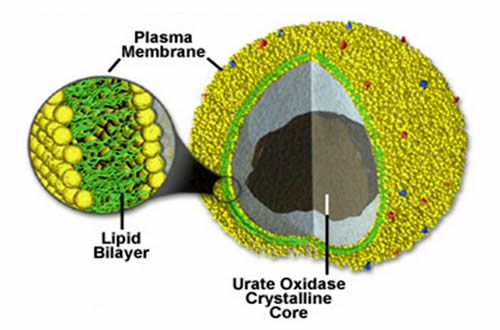 |
| Microbody - Peroxisome |
Microbodies, found in cells, are spherical, membrane-bound organelles that play a part in photorespiration and the conversion of fats into sucrose.
Peroxisomes and glyoxysomes are the two major types of microbodies in plant cells. Their vesicles (“packages”) vary in size from 0.3 to 1.5 micrometers in diameter and are self-replicating.
New microbodies are formed by incorporation of required proteins and lipids from the cytoplasm and subsequent splitting when they reach a certain size. Although structurally similar, their roles, and thus their contents, are different.
  |
Functions of Peroxisomes
Peroxisomes are present in leaves, and their oxidative enzymes are involved in the breakdown of hydrogen peroxide and, more important, in photorespiration. Photorespiration occurs when carbon dioxide levels in the leaves drop and oxygen levels increase, a typical phenomenon on hot, sunny days when a plant is experiencing some level of water stress.
Under these conditions, the enzyme (Rubisco) that normally catalyzes the attachment of carbon dioxide to ribulose bisphosphate (RuBP) begins to have a higher affinity for oxygen than for carbon dioxide.
When oxygen is used instead of carbon dioxide, RuBP is split into two molecules, phosphoglycolate and 3-phosphoglycerate (PGA). PGA can be used in another part of the Calvin cycle, but phosphoglycolate must be extensively processed to be useful.
Phosphoglycolate is hydrolyzed and converted to glycolate in the chloroplast. Glycolate is then transported out of the chloroplast and into nearby peroxisomes. Peroxisomal oxidase converts glycolate to glyoxylate, and hydrogen peroxide is produced as a by-product. Because hydrogen peroxide is toxic, it is quickly converted by a catalase to water and oxygen.
Glyoxylate goes through several more steps which involve reactions in the mitochondria and then back again in the peroxisomes. Eventually, glycerate is formed in the peroxisomes. Glycerate is then transported out of the peroxisomes and into a chloroplast, where it is converted to PGA, which can reenter the Calvin cycle.
Functions of Glyoxysomes
Glyoxysomes are found in the cells of fat-rich seeds. Fats are synthesized and stored as oil bodies, sometimes called spherosomes. Spherosomes are surrounded by a single layer of lipids instead of a lipid bilayer and are therefore not organelles in the strict sense. Glyoxysomes are responsible for converting fats and fatty acids into sucrose. The fat used by glyoxysomes comes from spherosomes.
Glyoxysomes are considered to be a type of peroxisome. In some plants, small glyoxysomes are found in the cotyledons of developing seeds. During germination and seedling development, they mature into fully functional glyoxysomes.
   |
They function until the fats are completely digested into sucrose. The energy from sucrose is required to drive early seedling development before photosynthesis begins. Large fat molecules are difficult to transport into the plant embryo; they must be converted to the more mobile sucrose molecules.
Breakdown of fats is a collaborative effort between enzyme-containing glyoxysomes and fat containing spherosomes. Direct contact between spherosomes and glyoxysomes must occur. Fats from spherosomes leak out close to the membrane of glyoxysomes.
Most of the activity of lipase enzymes does not take place in spherosomes but rather in or near the membrane of glyoxysomes. Lipases in glyoxysomes hydrolyze the ester bonds of fats and release the three fatty acids and one glycerol from each fat molecule.
Glycerol is converted, at the cost of adenosine triphosphate (ATP), to glycerol phosphate,which is then oxidized by nicotinamide adenine dinucleotide (NAD+) to dihydroxyacetone phosphate, most of which is converted to glucose.